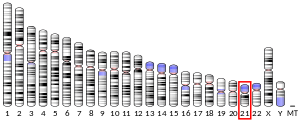CLIC6
Chloride intracellular channel protein 6 is a protein that in humans is encoded by the CLIC6 gene.[5][6]
This gene encodes a member of the chloride intracellular channel family of proteins. The gene is part of a large triplicated region found on chromosomes 1, 6, and 21. An alternatively spliced transcript variant has been described, but its biological validity has not been determined.[6]
Interactions
CLIC6 has been shown to interact with Dopamine receptor D3.[7]
See also
References
- 1 2 3 GRCh38: Ensembl release 89: ENSG00000159212 - Ensembl, May 2017
- 1 2 3 GRCm38: Ensembl release 89: ENSMUSG00000022949 - Ensembl, May 2017
- ↑ "Human PubMed Reference:".
- ↑ "Mouse PubMed Reference:".
- ↑ Hattori M, Fujiyama A, Taylor TD, Watanabe H, Yada T, Park HS, Toyoda A, Ishii K, Totoki Y, Choi DK, Groner Y, Soeda E, Ohki M, Takagi T, Sakaki Y, Taudien S, Blechschmidt K, Polley A, Menzel U, Delabar J, Kumpf K, Lehmann R, Patterson D, Reichwald K, Rump A, Schillhabel M, Schudy A, Zimmermann W, Rosenthal A, Kudoh J, Schibuya K, Kawasaki K, Asakawa S, Shintani A, Sasaki T, Nagamine K, Mitsuyama S, Antonarakis SE, Minoshima S, Shimizu N, Nordsiek G, Hornischer K, Brant P, Scharfe M, Schon O, Desario A, Reichelt J, Kauer G, Blocker H, Ramser J, Beck A, Klages S, Hennig S, Riesselmann L, Dagand E, Haaf T, Wehrmeyer S, Borzym K, Gardiner K, Nizetic D, Francis F, Lehrach H, Reinhardt R, Yaspo ML (Jun 2000). "The DNA sequence of human chromosome 21". Nature. 405 (6784): 311–9. doi:10.1038/35012518. PMID 10830953.
- 1 2 "Entrez Gene: CLIC6 chloride intracellular channel 6".
- ↑ Griffon, Nathalie; Jeanneteau Freddy; Prieur Fanny; Diaz Jorge; Sokoloff Pierre (Sep 2003). "CLIC6, a member of the intracellular chloride channel family, interacts with dopamine D(2)-like receptors". Brain Res. Mol. Brain Res. Netherlands. 117 (1): 47–57. doi:10.1016/S0169-328X(03)00283-3. ISSN 0169-328X. PMID 14499480.
Further reading
- Singh H (2010). "Two decades with dimorphic Chloride Intracellular Channels (CLICs)". FEBS Letters. 584 (10): 2112–21. doi:10.1016/j.febslet.2010.03.013. PMID 20226783.
- Hillier LD, Lennon G, Becker M, et al. (1997). "Generation and analysis of 280,000 human expressed sequence tags". Genome Res. 6 (9): 807–28. doi:10.1101/gr.6.9.807. PMID 8889549.
- Strippoli P, D'Addabbo P, Lenzi L, et al. (2003). "Segmental paralogy in the human genome: a large-scale triplication on 1p, 6p, and 21q". Mamm. Genome. 13 (8): 456–62. doi:10.1007/s00335-001-2157-0. PMID 12226712.
- Strausberg RL, Feingold EA, Grouse LH, et al. (2003). "Generation and initial analysis of more than 15,000 full-length human and mouse cDNA sequences". Proc. Natl. Acad. Sci. U.S.A. 99 (26): 16899–903. Bibcode:2002PNAS...9916899M. doi:10.1073/pnas.242603899. PMC 139241. PMID 12477932.
- Scanlan MJ, Gout I, Gordon CM, et al. (2003). "Humoral immunity to human breast cancer: antigen definition and quantitative analysis of mRNA expression". Cancer Immun. 1: 4. PMID 12747765.
- Griffon N, Jeanneteau F, Prieur F, et al. (2003). "CLIC6, a member of the intracellular chloride channel family, interacts with dopamine D(2)-like receptors". Brain Res. Mol. Brain Res. 117 (1): 47–57. doi:10.1016/S0169-328X(03)00283-3. PMID 14499480.
- Friedli M, Guipponi M, Bertrand S, et al. (2004). "Identification of a novel member of the CLIC family, CLIC6, mapping to 21q22.12". Gene. 320: 31–40. doi:10.1016/S0378-1119(03)00830-8. PMID 14597386.
- Ota T, Suzuki Y, Nishikawa T, et al. (2004). "Complete sequencing and characterization of 21,243 full-length human cDNAs". Nat. Genet. 36 (1): 40–5. doi:10.1038/ng1285. PMID 14702039.
- Gerhard DS, Wagner L, Feingold EA, et al. (2004). "The Status, Quality, and Expansion of the NIH Full-Length cDNA Project: The Mammalian Gene Collection (MGC)". Genome Res. 14 (10B): 2121–7. doi:10.1101/gr.2596504. PMC 528928. PMID 15489334.
External links
- CLIC6+protein,+human at the US National Library of Medicine Medical Subject Headings (MeSH)
- Human CLIC6 genome location and CLIC6 gene details page in the UCSC Genome Browser.
This article incorporates text from the United States National Library of Medicine, which is in the public domain.
This article is issued from
Wikipedia.
The text is licensed under Creative Commons - Attribution - Sharealike.
Additional terms may apply for the media files.



